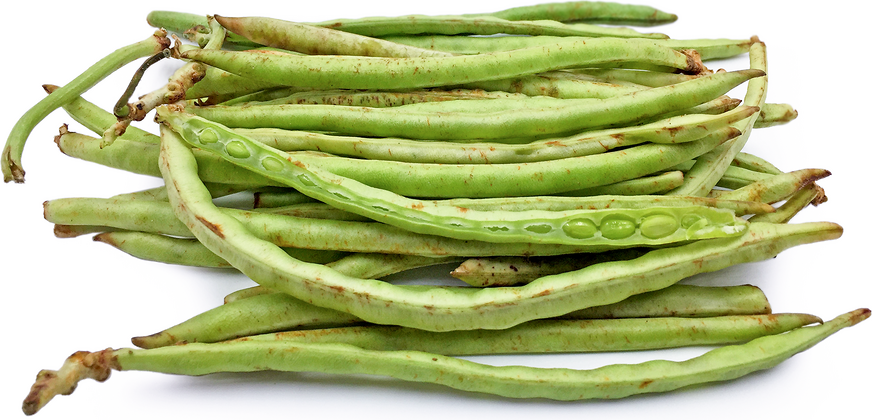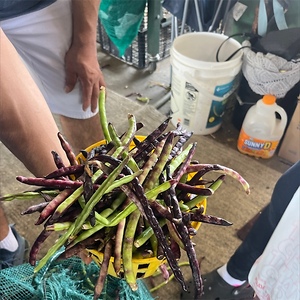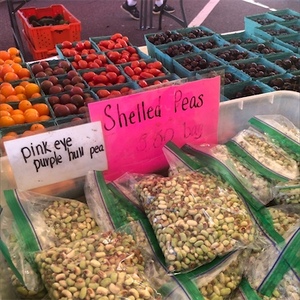


Top Pick Pink Eye Purple Hull Peas
Estimated Inventory, lb : 0
Description/Taste
Top Pick Pink Eye Purple Hull peas grow on semi-bushy plants that typically reach heights between 45 to 60 centimeters. The pods, which are 15 to 20 centimeters long, grow in clusters at the top of their green, leafy stems and contain 9 to 11 small beans each. Initially, the pea pods are a light green color but mature to a medium-purple. As the pods mature, the peas inside enlarge and turn a creamy white color. The peas are rounded, slightly kidney-shaped, and feature a pink “eye” where they attach to the pod. This eye darkens to a bright magenta as the peas mature. These peas are harvested at both immature and mature stages, with some left on the plant to begin drying naturally. Top Pick Pink Eye Purple Hull peas have a mild, earthy aroma that becomes more noticeable upon cooking. They have a tender texture and a subtly sweet and earthy flavor, complemented by a slight nuttiness.
Seasons/Availability
Top Pick Pinkeye Purple Hull peas are available in the late summer and fall months.
Current Facts
Top Pick Pink Eye Purple Hull peas belong to the Vigna unguiculata species in the Fabaceae family and are commonly known as Top Pick Pink Eyed Peas or Top Pinkeye Peas. This variety represents an improved version of the pinkeye cowpea, a type of Southern pea. Despite their “pea” name, these are actually beans within the legume family. The 'Top Pick' designation refers to the plant's growth pattern, with pods developing at the top, facilitating easier harvesting. They serve dual purposes as a cover crop and a food source for various animals, including deer, cattle, rabbits, and chickens, and can be pollinated by insects, birds, wind, human intervention, or other natural processes.
Nutritional Value
Top Pick Pinkeye Purple Hull peas are protein-rich and contain high amounts of fiber, thiamine, niacin, and riboflavin. These nutrients can promote good digestion, help lower cholesterol, help with heart function, muscles, and the nervous system, and helps with energy production by aiding in the metabolism of fats, drugs, and steroids. Top Pick Pinkeye Purple Hull peas contain lysine and tryptophan, essential amino acids that help the body. Lysine is vital for the development and maintenance of strong bones and teeth, thereby potentially reducing the risk of osteoporosis. Lysine serves as a building block for collagen, promoting skin elasticity, and aiding in wound healing by helping tissues repair themselves. Tryptophan plays a role in synthesizing serotonin, a neurotransmitter crucial for mood regulation. Serotonin impacts various functions in the body, including mood, sleep, and appetite. Adequate levels of serotonin promote feelings of well-being and happiness, thus helping to stave off depression and anxiety.
Applications
Consuming raw Top Pick Pink Eye Purple Hull peas is not advised due to the presence of lectins and other harmful compounds that require cooking to neutralize. These peas can be cooked, dried, pickled, canned, or fried, and are suitable substitutes in recipes typically calling for green beans. They feature prominently in the traditional dish Hoppin' John, which combines these peas with rice, chopped onions, garlic, bay leaves, and slices of bacon or ham hock. Additionally, Top Pick Pinkeye Purple Hull peas can be added to pea salads mixed with diced bell peppers, onions, and celery, or slow-cooked in a broth with smoked meats. They can be blended into a creamy pea soup, incorporated with Southern vegetables like collards or mustard greens, or added to pilafs and pasta dishes. These peas complement the flavors of smoky meats, okra, tomatoes, kale, spinach, thyme, rosemary, lemon, and vinegar. To preserve their freshness, store these peas in the refrigerator for up to two weeks. Dried beans should be kept in a cool, dry place for up to a month.
Ethnic/Cultural Info
Most Southerners in the United States have long been familiar with legumes such as the Top Pick Pink Eye Purple Hull, as peas of this type have been a staple in kitchens from Georgia to Texas since before the Civil War. These peas are a specific variety of black-eyed peas, which have been traditionally eaten for luck and prosperity since the Civil War era. Originally seen as modest livestock feed, black-eyed peas evolved into a symbol of survival and resilience among enslaved Africans and, later, freed African Americans. During challenging times, these peas were among the few nutritious foods available, thus becoming emblematic of good fortune. Symbolically, the peas represent coins or wealth, and eating them is thought to encourage financial prosperity. Typically, they are prepared with greens, representing money, and served alongside cornbread, which symbolizes gold. This meal is thus consumed as a hopeful gesture for prosperity and good luck in the new year.
Geography/History
Top Pick Pink Eye Purple Hull peas are originally from Africa. They have become a staple crop across the Southeast and have naturalized in regions such as Central and South America, Africa, and Asia. These peas excel in warm climates; they are drought-resistant and heat-tolerant, making them particularly well-suited to the warm, humid conditions typical of the Southern United States. Typically cultivated in gardens and commercial farms, these peas are not found growing wild. They were introduced to the Americas during colonial times via the slave trade, where slaves initially planted them. Their use quickly spread throughout the Southern United States, leading to the development of dozens of Southern bean varieties over the years. Today, Top Pick Pink Eye Purple Hull peas are available at farmers’ markets, specialty stores, and home gardens throughout the Southern U.S.









